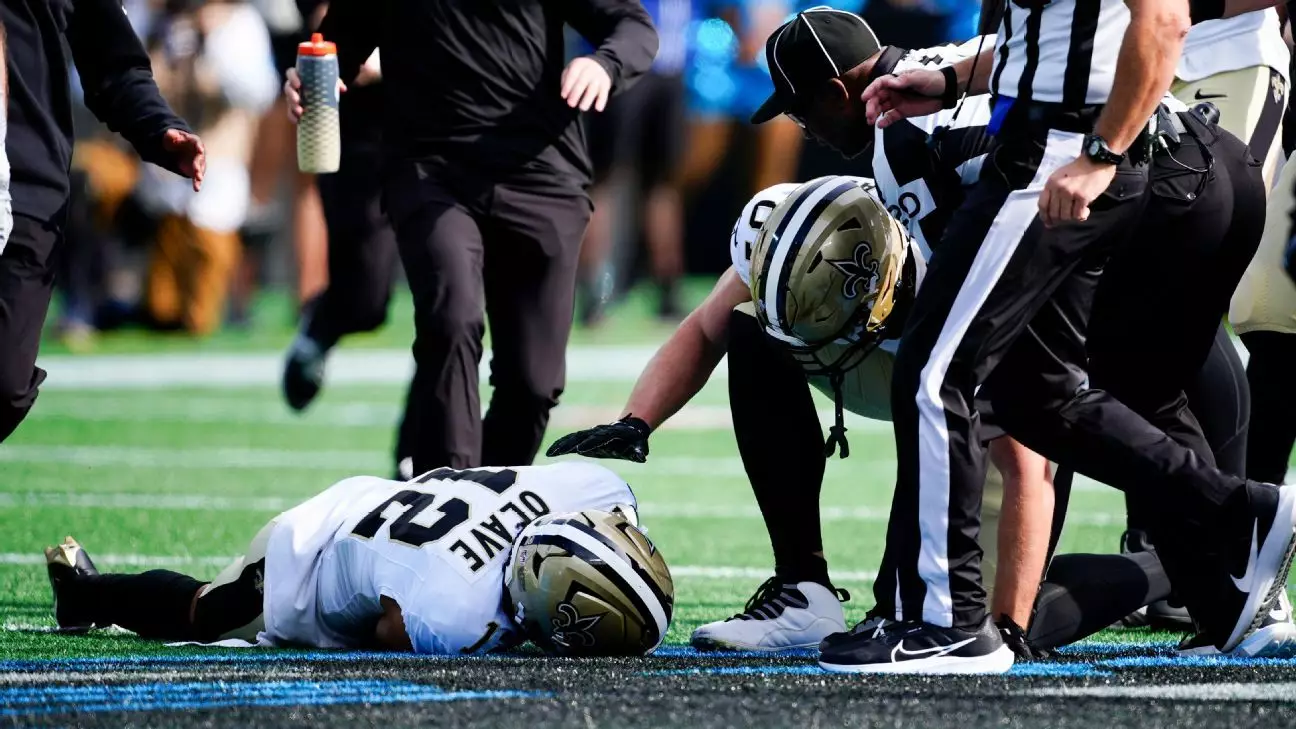The recent incident concerning New Orleans Saints wide receiver Chris Olave underscores a growing concern in professional football—the alarming frequency of concussions and their potential long-term impacts on players’ health. During a tense match against the Carolina Panthers, Olave found himself subjected to yet another head injury, marking his second concussion this season alone. This situation raises important questions not only about player safety protocols but also the measures in place to protect the physical and mental well-being of athletes in one of the most physically demanding sports.
When Olave was struck in the head and neck region by Panthers safety Xavier Woods, it wasn’t just a painful hit; it was a moment that could have far-reaching effects. The NFL has long been criticized for its handling of head injuries, and here lies a critical moment for self-reflection within the league. Players like Olave are part of a generations-long trend of athletes suffering from concussions, which can lead to chronic traumatic encephalopathy (CTE) and other neurological issues. As Olave was strapped to a backboard and carted off the field, the reality of the sport’s risks became visibly apparent, not just to fans but to everyone involved in the game.
Contention Among Teammates
The aftermath of Olave’s injury further highlighted tensions within the Saints’ locker room, particularly through the lens of former Saints wide receiver Michael Thomas’s pointed remarks about quarterback Derek Carr on social media. While some might view Thomas’s comments as a mere reaction to a friend’s injury, they reveal a deep-seated frustration that can jeopardize team morale. After the game, Thomas’s tweets implied that Carr’s decision-making was reckless and indirectly led to Olave’s injury.
Carr’s response was measured, as he acknowledged the complexity of team dynamics and emphasized love for all team members, including Thomas. This situation spotlights the volatile nature of interpersonal relationships within a high-stakes sports environment. In a world where the line between criticism and camaraderie is thin, it can be challenging to navigate feelings of betrayal and miscommunication. While Carr sought to deflect blame from himself, Thomas’s tweets indicate a clear frustration not only with Carr’s performance but possibly with the direction the team is heading under current leadership.
Social Media’s Role in Sports Culture
Social media’s role in sports cannot be overstated; it has the power to amplify voices and criticism in real time. Both Carr and Thomas’s statements circulated rapidly online, igniting debates among fans and analysts alike. This scenario poses significant implications for athletes as they must contend with public perceptions while also striving to maintain professionalism and focus on the game. The shift towards digital communication has created a landscape where grievances can be aired publicly rather than dealt with behind closed doors, transforming how disputes are handled and how unity is fostered within a team.
Olave’s brother also participated in this digital discourse, commenting on Thomas’s posts. His involvement serves as a reminder that familial ties extend into the professional realm, and the off-field relationships between players and their families can complicate their emotional responses. The supportive nature of family can be beneficial, but it can also fuel conflicts if fans perceive family members as having a stake in the discord.
The issue of player safety, particularly concerning concussions, extends beyond individual circumstances such as Olave’s. The league has implemented protocols to safeguard players, but recurring incidents suggest these measures are insufficient. Historically, players like Olave have dealt with various concussion-related events; he previously missed games due to this issue last season and has dealt with multiple evaluations this year alone. While he switched helmets in an effort to mitigate future risks, this emphasizes how proactive solutions must evolve in tandem with ongoing injury concerns.
The reality remains that no protective gear can completely prevent head injuries in a game characterized by contact at high speed. Legislative attention is being drawn to these issues, with calls for revised player safety protocols and more stringent monitoring of athletes during games. As Olave’s case circulates, it becomes a critical juncture for discussion concerning how the league approaches player health and safety overall.
As the Saints continue navigating this fractious period, their performance and cohesion might be tested amid external pressures that stem from their own reactions to incidents like Olave’s injury. It’s imperative for teams, management, and the league to cultivate a culture of collective responsibility that emphasizes empathy and communication. Players must feel secure in voicing their concerns without fear of backlash from teammates.
Ultimately, the ramifications of concussions and interpersonal conflicts present an ongoing dilemma for the league. Chris Olave’s injury is painful not only for him but for all immersed in the sport as they reflect on the importance of player health and the need for constructive dialogue in the face of adversity. Football is a beloved sport, but it comes with inherent risks. Tackling these issues head-on is crucial for the future of the game and the safety of its players.


Leave a Reply